Peugeot 3008 Hybrid 4 2012 Owner's Manual
Manufacturer: PEUGEOT, Model Year: 2012, Model line: 3008 Hybrid 4, Model: Peugeot 3008 Hybrid 4 2012Pages: 284, PDF Size: 55.64 MB
Page 121 of 284
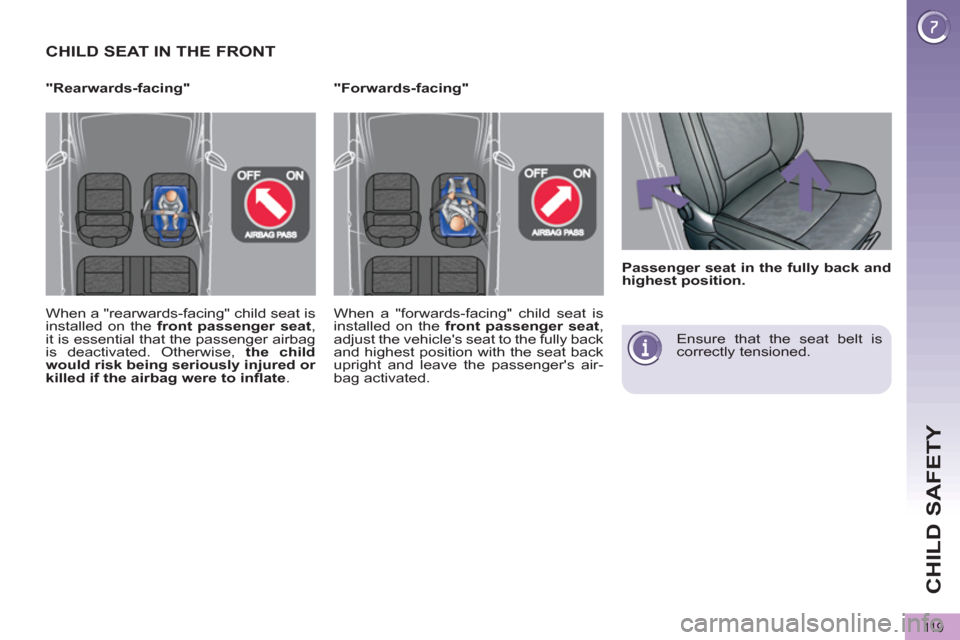
CHILD SAFETY
11 9
"Forwards-facing"
"Rearwards-facing"
CHILD SEAT IN THE FRONT
Passenger seat in the fully back and
highest position.
Ensure that the seat belt is
correctly tensioned. When a "rearwards-facing" child seat is
installed on the front passenger seat
,
it is essential that the passenger airbag
is deactivated. Otherwise, the child
would risk being seriously injured or
killed if the airbag were to infl ate
. When a "forwards-facing" child seat is
installed on the front passenger seat
,
adjust the vehicle's seat to the fully back
and highest position with the seat back
upright and leave the passenger's air-
bag activated.
Page 122 of 284
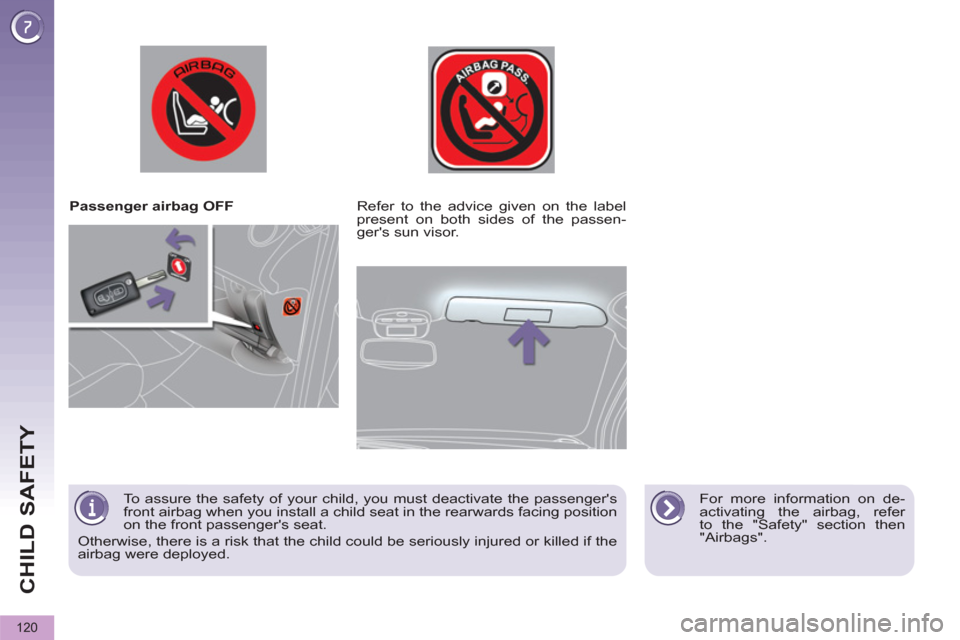
CHILD SAFETY
120
Passenger airbag OFF
For more information on de-
activating the airbag, refer
to the "Safety" section then
"Airbags".
Refer to the advice given on the label
present on both sides of the passen-
ger's sun visor.
To assure the safety of your child, you must deactivate the passenger's
front airbag when you install a child seat in the rearwards facing position
on the front passenger's seat.
Otherwise, there is a risk that the child could be seriously injured or killed if the
airbag were deployed.
Page 123 of 284
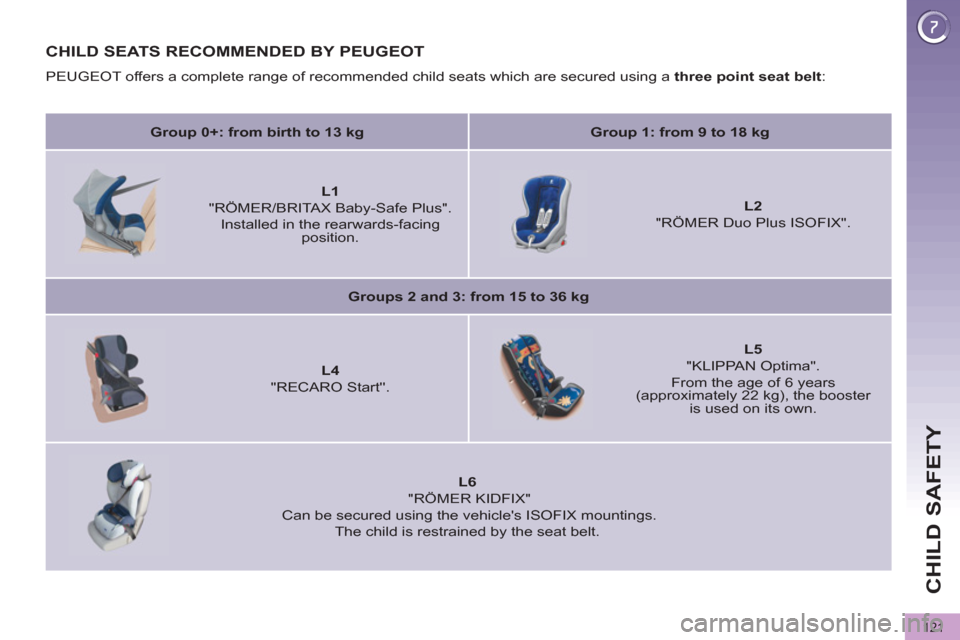
CHILD SAFETY
121
CHILD SEATS RECOMMENDED BY PEUGEOT
PEUGEOT offers a complete range of recommended child seats which are secured using a three point seat belt
:
Group 0+: from birth to 13 kg
Group 1: from 9 to 18 kg
L1
"RÖMER/BRITAX Baby-Safe Plus".
Installed in the rearwards-facing
position.
L2
"RÖMER Duo Plus ISOFIX".
Groups 2 and 3: from 15 to 36 kg
L4
"RECARO Start''.
L5
"KLIPPAN Optima".
From the age of 6 years
(approximately 22 kg), the booster
is used on its own.
L6
"RÖMER KIDFIX"
Can be secured using the vehicle's ISOFIX mountings.
The child is restrained by the seat belt.
Page 124 of 284
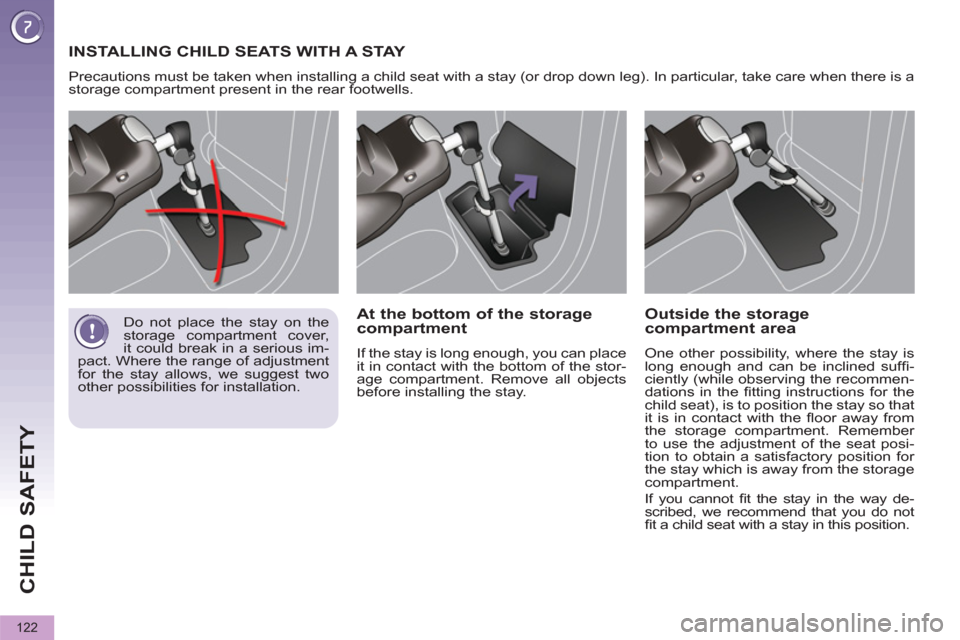
CHILD SAFETY
122
INSTALLING CHILD SEATS WITH A STAY
Precautions must be taken when installing a child seat with a stay (or drop down leg). In particular, take care when there is a
storage compartment present in the rear footwells.
At the bottom of the storage
compartment
If the stay is long enough, you can place
it in contact with the bottom of the stor-
age compartment. Remove all objects
before installing the stay.
Outside the storage
compartment area
One other possibility, where the stay is
long enough and can be inclined suffi -
ciently (while observing the recommen-
dations in the fi tting instructions for the
child seat), is to position the stay so that
it is in contact with the fl oor away from
the storage compartment. Remember
to use the adjustment of the seat posi-
tion to obtain a satisfactory position for
the stay which is away from the storage
compartment.
If you cannot fi t the stay in the way de-
scribed, we recommend that you do not
fi t a child seat with a stay in this position. Do not place the stay on the
storage compartment cover,
it could break in a serious im-
pact. Where the range of adjustment
for the stay allows, we suggest two
other possibilities for installation.
Page 125 of 284
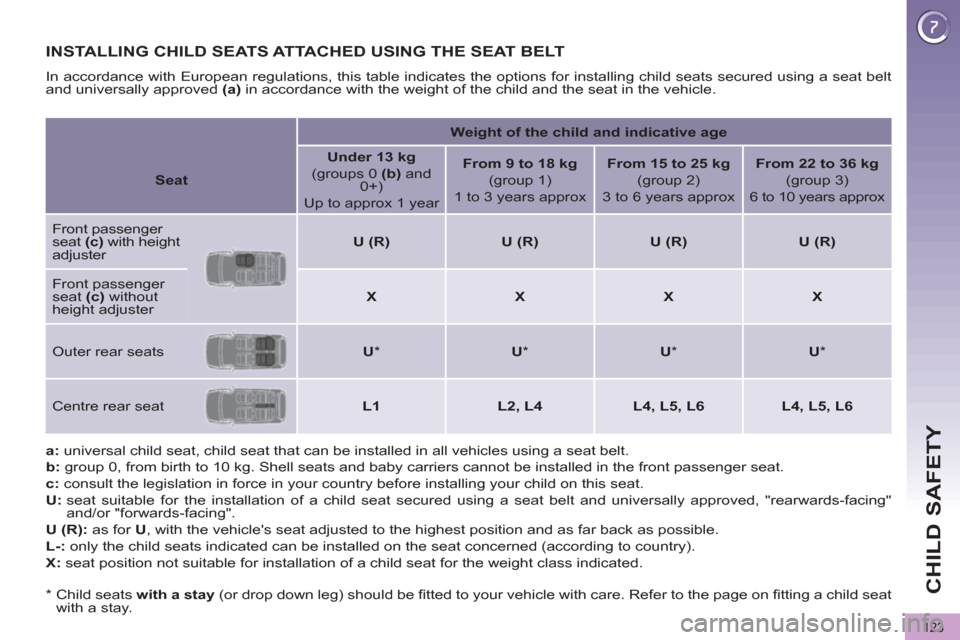
CHILD SAFETY
123
INSTALLING CHILD SEATS ATTACHED USING THE SEAT BELT
In accordance with European regulations, this table indicates the options for installing child seats secured using a seat belt
and universally approved (a)
in accordance with the weight of the child and the seat in the vehicle.
a:
universal child seat, child seat that can be installed in all vehicles using a seat belt.
b:
group 0, from birth to 10 kg. Shell seats and baby carriers cannot be installed in the front passenger seat.
c:
consult the legislation in force in your country before installing your child on this seat.
U:
seat suitable for the installation of a child seat secured using a seat belt and universally approved, "rearwards-facing"
and/or "forwards-facing".
U (R):
as for U
, with the vehicle's seat adjusted to the highest position and as far back as possible.
L-:
only the child seats indicated can be installed on the seat concerned (according to country).
X:
seat position not suitable for installation of a child seat for the weight class indicated.
Weight of the child and indicative age
Seat
Under 13 kg
(groups 0 (b)
and
0+)
Up to approx 1 year
From 9 to 18 kg
(group 1)
1 to 3 years approx
From 15 to 25 kg
(group 2)
3 to 6 years approx
From 22 to 36 kg
(group 3)
6 to 10 years approx
Front passenger
seat (c)
with height
adjuster
U (R)
U (R)
U (R)
U (R)
Front passenger
seat (c)
without
height adjuster
X
X
X
X
Outer rear seats
U
*
U
*
U
*
U
*
Centre rear seat
L1
L2, L4
L4, L5, L6
L4, L5, L6
*
Child seats with a
stay
(or drop down leg) should be fi tted to your vehicle with care. Refer to the page on fi tting a child seat
with a stay.
Page 126 of 284
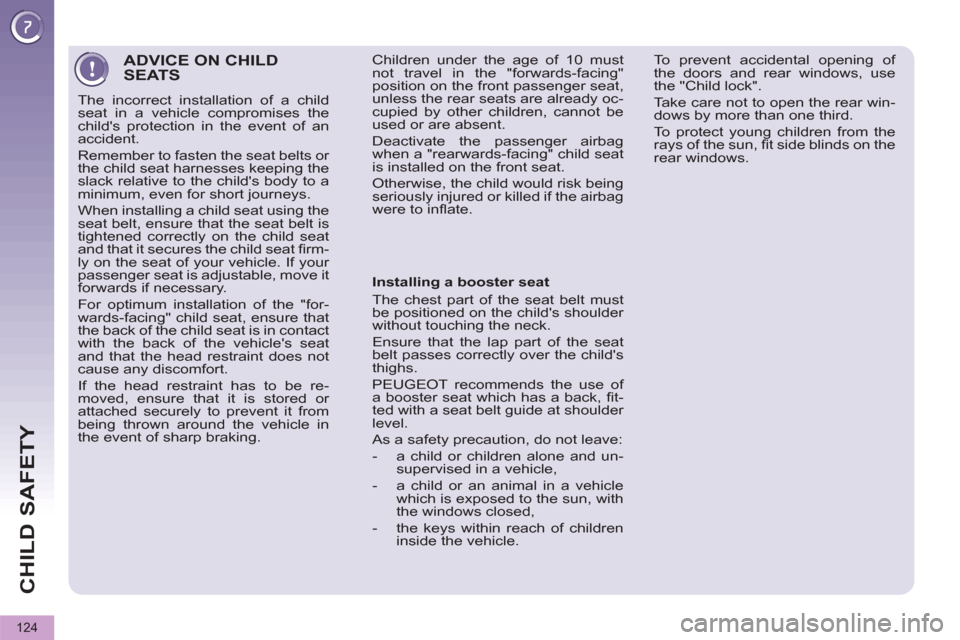
CHILD SAFETY
124
ADVICE ON CHILD
SEATS
The incorrect installation of a child
seat in a vehicle compromises the
child's protection in the event of an
accident.
Remember to fasten the seat belts or
the child seat harnesses keeping the
slack relative to the child's body to a
minimum, even for short journeys.
When installing a child seat using the
seat belt, ensure that the seat belt is
tightened correctly on the child seat
and that it secures the child seat fi rm-
ly on the seat of your vehicle. If your
passenger seat is adjustable, move it
forwards if necessary.
For optimum installation of the "for-
wards-facing" child seat, ensure that
the back of the child seat is in contact
with the back of the vehicle's seat
and that the head restraint does not
cause any discomfort.
If the head restraint has to be re-
moved, ensure that it is stored or
attached securely to prevent it from
being thrown around the vehicle in
the event of sharp braking.
Installing a booster seat
The chest part of the seat belt must
be positioned on the child's shoulder
without touching the neck.
Ensure that the lap part of the seat
belt passes correctly over the child's
thighs.
PEUGEOT recommends the use of
a booster seat which has a back, fi t-
ted with a seat belt guide at shoulder
level.
As a safety precaution, do not leave:
- a child or children alone and un-
supervised in a vehicle,
- a child or an animal in a vehicle
which is exposed to the sun, with
the windows closed,
- the keys within reach of children
inside the vehicle. To prevent accidental opening of
the doors and rear windows, use
the "Child lock".
Take care not to open the rear win-
dows by more than one third.
To protect young children from the
rays of the sun, fi t side blinds on the
rear windows.
Children under the age of 10 must
not travel in the "forwards-facing"
position on the front passenger seat,
unless the rear seats are already oc-
cupied by other children, cannot be
used or are absent.
Deactivate the passenger airbag
when a "rearwards-facing" child seat
is installed on the front seat.
Otherwise, the child would risk being
seriously injured or killed if the airbag
were to infl ate.
Page 127 of 284
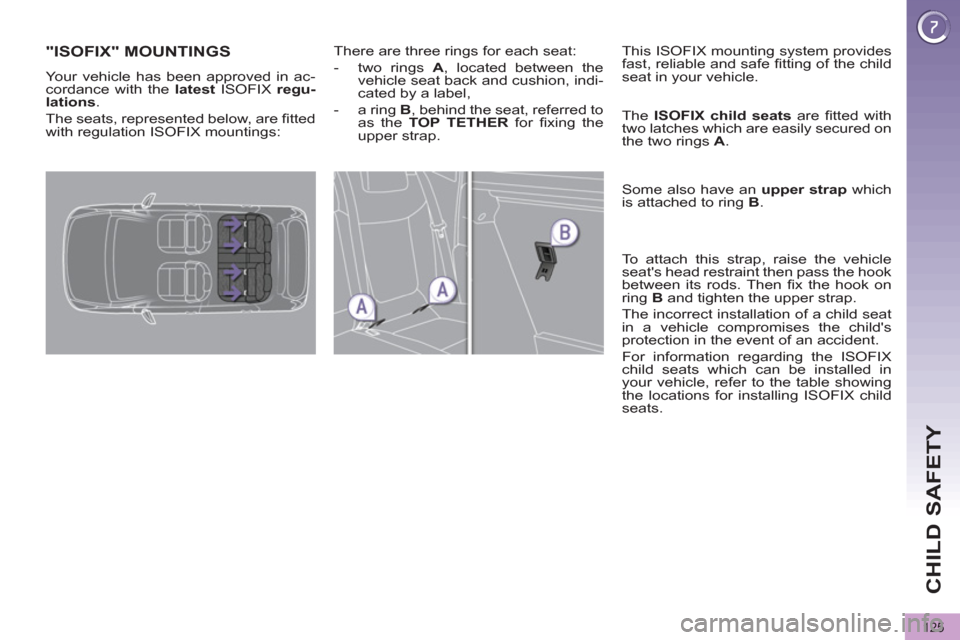
CHILD SAFETY
125
"ISOFIX" MOUNTINGS
Your vehicle has been approved in ac-
cordance with the latest
ISOFIX regu-
lation
s
.
The seats, represented below, are fi tted
with regulation ISOFIX mountings: There are three rings for each seat:
- two rings A
, located between the
vehicle seat back and cushion, indi-
cated by a label,
- a ring B
, behind the seat, referred to
as the TOP TETHER
for fi xing the
upper strap. This ISOFIX mounting system provides
fast, reliable and safe fi tting of the child
seat in your vehicle.
The ISOFIX child seats
are fi tted with
two latches which are easily secured on
the two rings A
.
Some also have an upper strap
which
is attached to ring B
.
To attach this strap, raise the vehicle
seat's head restraint then pass the hook
between its rods. Then fi x the hook on
ring B
and tighten the upper strap.
The incorrect installation of a child seat
in a vehicle compromises the child's
protection in the event of an accident.
For information regarding the ISOFIX
child seats which can be installed in
your vehicle, refer to the table showing
the locations for installing ISOFIX child
seats.
Page 128 of 284
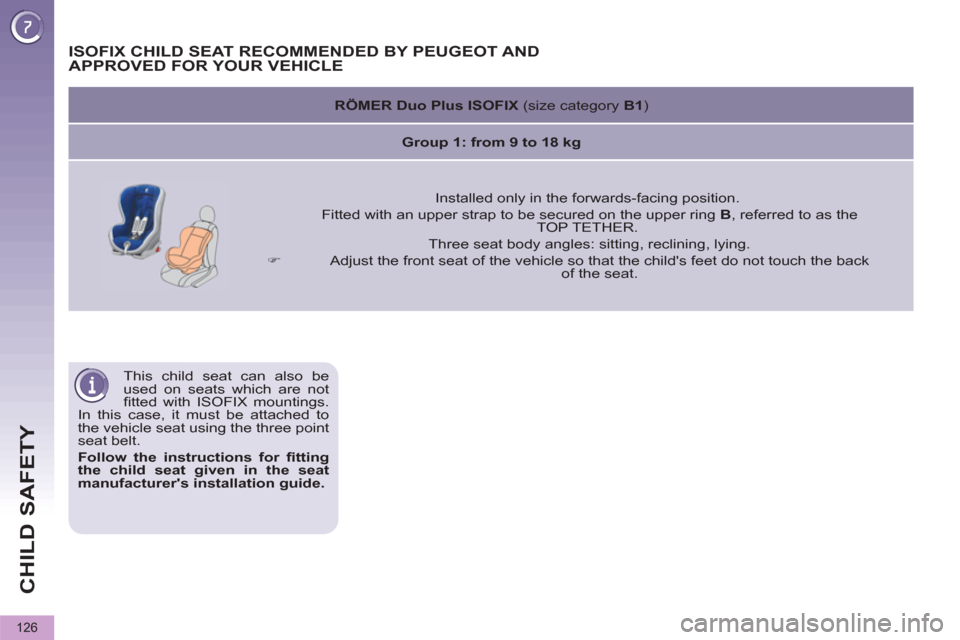
CHILD SAFETY
126
This child seat can also be
used on seats which are not
fi tted with ISOFIX mountings.
In this case, it must be attached to
the vehicle seat using the three point
seat belt.
Follow the instructions for fi tting
the child seat given in the seat
manufacturer's installation guide.
ISOFIX CHILD SEAT RECOMMENDED BY PEUGEOT AND
APPROVED FOR YOUR VEHICLE
RÖMER
Duo Plus ISOFIX
(size category B1
)
Group 1: from 9 to 18 kg
Installed only in the forwards-facing position.
Fitted with an upper strap to be secured on the upper ring B
, referred to as the
TOP TETHER.
Three seat body angles: sitting, reclining, lying.
�)
Adjust the front seat of the vehicle so that the child's feet do not touch the back
of the seat.
Page 129 of 284
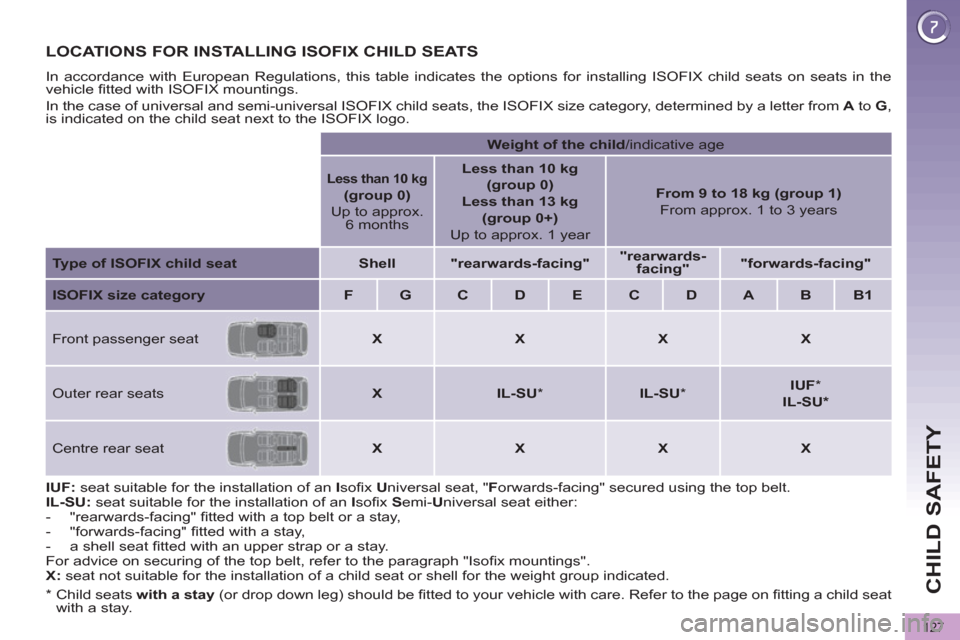
CHILD SAFETY
127
LOCATIONS FOR INSTALLING ISOFIX CHILD SEATS
In accordance with European Regulations, this table indicates the options for installing ISOFIX child seats on seats in the
vehicle fi tted with ISOFIX mountings.
In the case of universal and semi-universal ISOFIX child seats, the ISOFIX size category, determined by a letter from A
to G
,
is indicated on the child seat next to the ISOFIX logo.
IUF:
seat suitable for the installation of an I
sofi x U
niversal seat, " F
orwards-facing" secured using the top belt.
IL-SU:
seat suitable for the installation of an I
sofi x S
emi- U
niversal seat either:
- "rearwards-facing" fi tted with a top belt or a stay,
- "forwards-facing" fi tted with a stay,
- a shell seat fi tted with an upper strap or a stay.
For advice on securing of the top belt, refer to the paragraph "Isofi x mountings".
X:
seat not suitable for the installation of a child seat or shell for the weight group indicated.
Weight of the child
/indicative age
Less than 10 kg
(group 0)
Up to approx.
6 months
Less than 10 kg
(group 0)
Less than 13 kg
(group 0+)
Up to approx. 1 year
From 9 to 18 kg (group 1)
From approx. 1 to 3 years
Type of ISOFIX child seat
Shell
"rearwards-facing"
"rearwards-
facing"
"forwards-facing"
ISOFIX size category
F
G
C
D
E
C
D
A
B
B1
Front passenger seat
X
X
X
X
Outer rear seats
X
IL-SU
*
IL-SU
*
IUF
*
IL-SU *
Centre rear seat
X
X
X
X
*
Child seats with a
stay
(or drop down leg) should be fi tted to your vehicle with care. Refer to the page on fi tting a child seat
with a stay.
Page 130 of 284
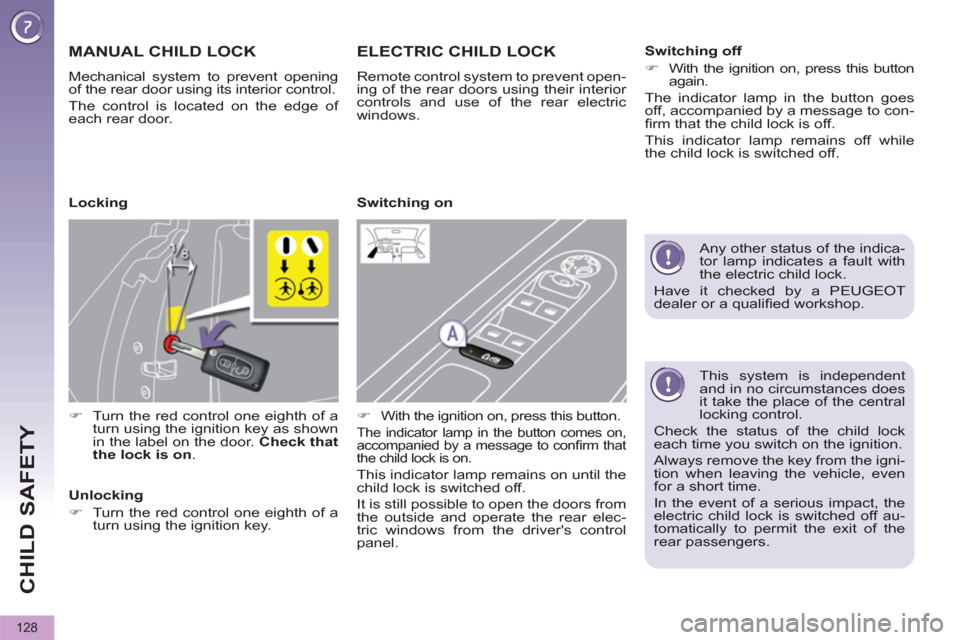
CHILD SAFETY
128
This system is independent
and in no circumstances does
it take the place of the central
locking control.
Check the status of the child lock
each time you switch on the ignition.
Always remove the key from the igni-
tion when leaving the vehicle, even
for a short time.
In the event of a serious impact, the
electric child lock is switched off au-
tomatically to permit the exit of the
rear passengers.
MANUAL CHILD LOCK
Mechanical system to prevent opening
of the rear door using its interior control.
The control is located on the edge of
each rear door.
�)
Turn the red control one eighth of a
turn using the ignition key as shown
in the label on the door. Check that
the lock is on
.
ELECTRIC CHILD LOCK
Remote control system to prevent open-
ing of the rear doors using their interior
controls and use of the rear electric
windows.
�)
With the ignition on, press this button.
The indicator lamp in the button comes on,
accompanied by a message to confi rm that
the child lock is on.
This indicator lamp remains on until the
child lock is switched off.
It is still possible to open the doors from
the outside and operate the rear elec-
tric windows from the driver's control
panel.
Locking
Unlocking
�)
Turn the red control one eighth of a
turn using the ignition key.
Switching on
Switching off
�)
With the ignition on, press this button
again.
The indicator lamp in the button goes
off, accompanied by a message to con-
fi rm that the child lock is off.
This indicator lamp remains off while
the child lock is switched off.
Any other status of the indica-
tor lamp indicates a fault with
the electric child lock.
Have it checked by a PEUGEOT
dealer or a qualifi ed workshop.